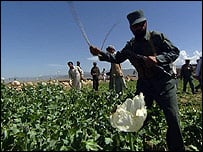Record opium crop in southern Afghanistan

· Region set to become world’s biggest supplier
· Cocaine consumption up in Europe, says UN report
Helmand province in southern Afghanistan, where some 7,000 British troops are based, is on the verge of becoming the world’s biggest drugs supplier, cultivating more opium than entire countries such as Burma, Morocco, or even Colombia, the UN warned yesterday.
The region was largely responsible for a huge increase last year in Afghanistan’s opium poppy harvest, the origin of most of the heroin on the streets of Britain and mainland Europe. And Helmand’s poppy harvest is expected to increase again this year, according to the latest annual report of the UN Office on Drugs and Crime.
“Curing Helmand of its drug and insurgency cancer will rid the world of the most dangerous source of its most dangerous narcotic and go a long way to bring security to the region,” said Antonio Maria Costa, the UN agency’s executive director.
The report will not be welcome reading for the British government. Five years ago, Tony Blair said Britain would take responsibility for overseeing Afghanistan’s anti-narcotics programme. Last year, Kim Howells, the Foreign Office minister, said an increase in the opium harvest planted before British troops arrived in Helmand was one thing, a further rise this year – now predicted by UN and British officials – would be quite another.
“Drugs and the insurgency are intrinsically linked,” a British official admitted yesterday. British military commanders, meanwhile, warn that attempts to eradicate the poppy crop without providing alternative incomes will simply increase hostility to foreign troops and increase support for the Taliban.
A US proposal to spray the poppy crop was vetoed by the Afghan president, Hamid Karzai.
British officials say their priority is to attack the drug traffickers and their laboratories before embarking on a long-term programme to provide Afghans with alternative crops to farm. However, the UN report says that even removing the top Afghan drug lords may not have any effect on cross-border trade with dealers in Pakistan, Iran, and to the north of the country.
A dramatic 49% increase last year to a record opium poppy harvest in the country led to a new record in the world production of opium, the UN says. Afghanistan accounts for 92% of global illict opium production. The total export value of the country’s opium harvest is estimated by the UN to amount to more than $3bn (£1.5bn), almost half the size of the country’s entire gross domestic product. More than 12% of Afghanistan’s population of 23 million is involved in opium poppy cultivation.
There are about 11 million heroin addicts in the world, of which 3.3 million are in Europe, according to the UN report. It says the rise in Afghanistan’s opium cultivation in 2006 offset the sixth successive year of decline in opium cultivation in south-east Asia.
The report says that coca cultivation is falling in South America and cocaine consumption is declining in the US. However, consumption is rising in Europe, particularly in Britain, Italy and Spain, the main entry point for cocaine in Europe.
The report also suggests that overall drug abuse is being contained, with total production, trafficking, and consumption, of illicit drugs largely stabilised. Drug seizures have continued to increase, though it adds that traffickers are establishing new routes, exploiting Africa in particular.
“This threat needs to be addressed quickly to stamp out organised crime, money laundering and corruption and to prevent the spread of drug use that could cause havoc across a continent already plagued by many other tragedies,” Mr Costa said.
Cannabis, grown in 172 countries, often in small plots by users themselves, continues to account for the vast majority of illegal drug use and is consumed by about 160 million people, the report says.
Amphetamine-type stimulants – including ecstasy – remain the second-most widely consumed group of substances, it says. Over the 2005-2006 period, some 25 million people are estimated to have used amphetamines at least once in the previous 12 months, about the same as a year earlier.
At a glance
· A 49% increase in opium production in Afghanistan has seen a new record in the world production
· Afghanistan accounts for 92% of global illict opium production.
· Of the 11m heroin addicts in the world, 3.3m of them in Europe
· Cannabis is consumed by 160m people worldwide
· Over the 2005-2006 period, 25m people are estimated to have used amphetamines at least once in the previous 12 months
· More than 12% of Afghanistan’s population is involved in poppy cultivation.

